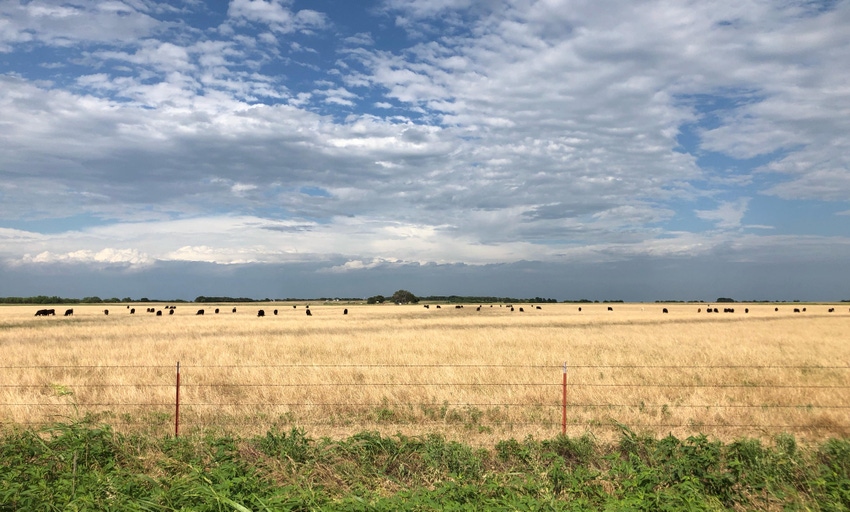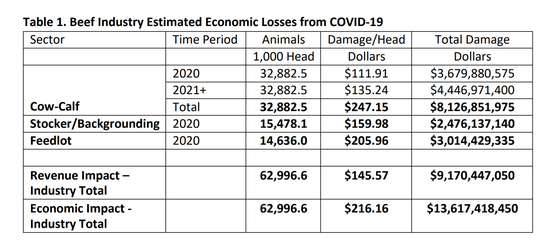Relief funds meant for producers were divided among multiple commodities, many of which already have government programs.
April 15, 2020

A study released this week estimates that cattle industry losses as a result of the COVID-19 pandemic will reach $13.6 billion. The study was commissioned by the National Cattlemen’s Beef Assn. (NCBA) and conducted by a team of industry-leading agricultural economists led by Derrell Peel, Breedlove professor of agribusiness and extension livestock marketing specialist at Oklahoma State University, to assist U.S. Department of Agriculture in determining how best to allocate Coronavirus Aid, Relief & Economic Security (CARES) Act relief funds to cattle producers.
The study showed that cow/calf producers will see the largest impact, with COVID-19-related losses totaling an estimated $3.7 billion, or $111.91 per head for each mature breeding animal in the U.S. Without offsetting relief payments, those losses could increase by $135.24 per mature breeding animal, for an additional impact totaling $4.45 billion in the coming years.
Stocker/backgrounder segment losses were estimated at $159.98 per head, for a total economic impact of $2.5 billion in 2020, while feeding sector losses were estimated at $3.0 billion, or $205.96 per head.

“This study confirms that cattle producers have suffered massive economic damage as a result of the COVID-19 outbreak, and those losses will continue to mount for years to come, driving many producers to the brink of collapse and beyond if relief funds aren’t made available soon,” NCBA chief executive officer Colin Woodall said. “This study also clearly illustrates the fact that while the relief funds provided by Congress were a good first step, there remains a massive need for more funding to be allocated as soon as members of Congress reconvene.”
Woodall pointed out that relief funds that were meant to provide aid directly to cattle producers were divided among multiple commodities, many of which already have government programs in place to support production. However, he said cattle producers have always maintained their independence from government programs, and most operate today without the safety net others enjoy.
“It’s only because of the extraordinary circumstances we face today that cattle producers need relief. While we appreciate the many members of Congress who supported the cattle industry and ensured cattle producers were eligible for relief funds, we need these same members to do more to make certain every cattle producer who needs relief can access funding. That’s why we’re calling today for additional funds to be made available specifically for [cattle producers],” Woodall said.
Study summary
The study conducted by Oklahoma State University estimated total beef cattle industry damages of $13.6 billion as of early April 2020. Damage estimates include:
Revenue losses of $3.7 billion in 2020 to the cow/calf sector, equivalent to $111.91 per head for each mature breeding animal in the U.S., with additional long-term damages of $4.45 billion, or another $135.24 per mature breeding animal, to the cow/calf sector in coming years if these damages are not offset.
Revenue losses of $2.5 billion to the U.S. stocker/backgrounding sector in 2020, equivalent to $159.98 per head.
Revenue losses of $3.0 billion to the U.S. cattle feeding sector in 2020, equivalent to $205.96 per head.
The study noted that the current situation is very fluid and uncertain, and additional damages are likely.
The economic damage assessment was conducted by Peel and Amy Hagerman with Oklahoma State University; Dustin Aherin and Don Close with Rabobank; Randy Blach with CattleFax; Kenneth Burdine with the University of Kentucky; Josh Maples with Mississippi State University; James Robb with the Livestock Marketing Information Center, and Glynn Tonsor with Kansas State University.
The full report can be viewed here.
You May Also Like



